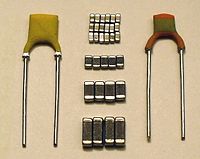
Photo from wikipedia
Based on porous silicate glasses obtained by ion exchange, glass-ceramic materials containing a solid solution of barium-strontium titanate with a dielectric constant of more than 100 at microwaves, were synthesized… Click to show full abstract
Based on porous silicate glasses obtained by ion exchange, glass-ceramic materials containing a solid solution of barium-strontium titanate with a dielectric constant of more than 100 at microwaves, were synthesized for the first time. Glass-ceramic structures were studied using X-ray diffraction, secondary electron microscopy, Mössbauer spectroscopy and porometry methods. Electrical characteristics such as permittivity and losses of as-prepared and annealed in oxygen medium samples were also investigated at microwaves. It was shown that the method of obtaining porous glasses, due to ion exchange between KFeSi glass and LiNO3 and NaNO3 melts, allows for controlling a wide range of pore sizes and makes it possible to form glass porous structures with pores of the required size. The efficiency of the process of filling a porous matrix with a ferroelectric filler was investigated and the average depth of its penetration was estimated. It was shown that annealing glass-ceramic structures in an oxygen environment had a positive effect on their structural and electrical characteristics. Glass-ceramic structures demonstrate a significant increase in permittivity and a decrease in losses after high-temperature treatment in oxygen.
Journal Title: Materials
Year Published: 2020
Link to full text (if available)
Share on Social Media: Sign Up to like & get
recommendations!